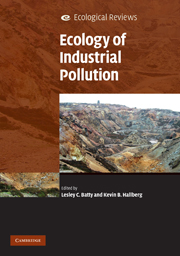Book contents
- Frontmatter
- Contents
- List of contributors
- Preface
- Acknowledgements
- 1 Consequences of living in an industrial world
- 2 Metallophytes: the unique biological resource, its ecology and conservational status in Europe, central Africa and Latin America
- 3 Lichens and industrial pollution
- 4 The impacts of metalliferous drainage on aquatic communities in streams and rivers
- 5 Impacts of emerging contaminants on the environment
- 6 Ecological monitoring and assessment of pollution in rivers
- 7 Detecting ecological effects of pollutants in the aquatic environment
- 8 With the benefit of hindsight: the utility of palaeoecology in wetland condition assessment and identification of restoration targets
- 9 An ecological risk assessment framework for assessing risks from contaminated land in England and Wales
- 10 Diversity and evolution of micro-organisms and pathways for the degradation of environmental contaminants: a case study with the s-triazine herbicides
- 11 The microbial ecology of land and water contaminated with radioactive waste: towards the development of bioremediation options for the nuclear industry
- 12 The microbial ecology of remediating industrially contaminated land: sorting out the bugs in the system
- 13 Ecological recovery in a river polluted to its sources: the River Tame in the English Midlands
- 14 Manchester Ship Canal and Salford Quays: industrial legacy and ecological restoration
- 15 Large-scale mine site restoration of Australian eucalypt forests after bauxite mining: soil management and ecosystem development
- 16 Sustaining industrial activity and ecological quality: the potential role of an ecosystem services approach
- Index
- Plate section
- References
6 - Ecological monitoring and assessment of pollution in rivers
Published online by Cambridge University Press: 05 June 2012
- Frontmatter
- Contents
- List of contributors
- Preface
- Acknowledgements
- 1 Consequences of living in an industrial world
- 2 Metallophytes: the unique biological resource, its ecology and conservational status in Europe, central Africa and Latin America
- 3 Lichens and industrial pollution
- 4 The impacts of metalliferous drainage on aquatic communities in streams and rivers
- 5 Impacts of emerging contaminants on the environment
- 6 Ecological monitoring and assessment of pollution in rivers
- 7 Detecting ecological effects of pollutants in the aquatic environment
- 8 With the benefit of hindsight: the utility of palaeoecology in wetland condition assessment and identification of restoration targets
- 9 An ecological risk assessment framework for assessing risks from contaminated land in England and Wales
- 10 Diversity and evolution of micro-organisms and pathways for the degradation of environmental contaminants: a case study with the s-triazine herbicides
- 11 The microbial ecology of land and water contaminated with radioactive waste: towards the development of bioremediation options for the nuclear industry
- 12 The microbial ecology of remediating industrially contaminated land: sorting out the bugs in the system
- 13 Ecological recovery in a river polluted to its sources: the River Tame in the English Midlands
- 14 Manchester Ship Canal and Salford Quays: industrial legacy and ecological restoration
- 15 Large-scale mine site restoration of Australian eucalypt forests after bauxite mining: soil management and ecosystem development
- 16 Sustaining industrial activity and ecological quality: the potential role of an ecosystem services approach
- Index
- Plate section
- References
Summary
Introduction
Many organisms respond to pollution in a predictable way, and it has long been realised that the biota can be used to determine the extent of pollution at a site, a technique termed biomonitoring. Much of the science of biomonitoring developed in aquatic systems, driven by concerns about the impact of industrial and domestic pollution on potable water resources. Over the past century, aquatic biomonitoring has travelled a long way from the early methodologies, and much about the pitfalls and benefits of using biota to assess pollution or other stressors has been discovered. Here we describe the history of biomonitoring and how our understanding has developed, with particular focus on RIVPACS (River InVertebrate Prediction And Classification System). This system marked a major advance in biomonitoring techniques, introducing the reference condition approach, where the physical and geographical characteristics of the river were taken into account when determining what taxa would be expected to be present if the site were not polluted. Assessment of a site was then based on a comparison of the observed community and derived scores, to that expected if the site were not polluted. RIVPACS was also the first biomonitoring tool to incorporate a measure of uncertainty; any assessment is based on spatially and temporally variable samples and it is necessary to calculate the confidence associated with the quality class derived using these samples.
- Type
- Chapter
- Information
- Ecology of Industrial Pollution , pp. 126 - 146Publisher: Cambridge University PressPrint publication year: 2010
References
- 16
- Cited by



